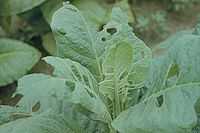Heliothis virescens
| Heliothis virescens | |
|---|---|
 | |
| Scientific classification | |
| Kingdom: | Animalia |
| Phylum: | Arthropoda |
| Class: | Insecta |
| Order: | Lepidoptera |
| Family: | Noctuidae |
| Genus: | Heliothis |
| Species: | H. virescens |
| Binomial name | |
| Heliothis virescens Fabricius, 1777 | |
| Synonyms | |
| |
The tobacco budworm (Heliothis virescens) is a moth of the Noctuidae family. It is found in Virginia, Georgia, Florida, Texas, Mexico, Guatemala, Panama, Brazil and the Antilles.[1]

The wingspan is 28–35 mm.
The larvae feed on various crops, most notably Nicotiana species. The tobacco budworm is one of the most destructive pests of the tobacco. Eggs are laid on the tobacco leaves. The emerging larvae are light to dark green and have several longitudinal pale stripes. They may chew small holes in the leaves before they reach the buds. Larvae then damage the bud or growing tip of the plant. The leaves that expand from the buds are often ragged and distorted.


Other recorded food plants include Penstemon laevigatus, Desmodium species, Lespedeza bicolour, Medicago lupulina, Geranium dissectum, Rhexia species, Rumex species, Physalis species, Lonicera japonica, Lupinus species, Ipomoea species, Jacquemontia tamnifolia, Passiflora species, Sida spinosa, Helianthus species, Linaria canadensis and Abutilon theophrasti.
The braconid wasp Microplitis croceipes, which deposits its eggs inside a living caterpillar, is an important parasitoid of both H. virescens and the related species Helicoverpa zea.[2]
References
- ↑ Markku Savela (November 6, 2008). "Heliothis genus". funet.fi. Retrieved 2009-03-12.
- ↑ Tomberlin, Jeffery K; Moukaram Tertuliano, Glen Rains, W. Joe Lewis (September 2005). "Conditioned Microplitis croceipes Cresson (Hymenoptera: Braconidae) Detect and Respond to 2,4-DNT: Development of a Biological Sensor" (pdf). J. Forensic Sci. 50 (5). doi:10.1520/JFS2005014. Retrieved 21 February 2011.